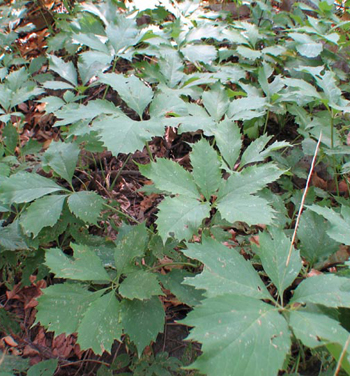Contents:
Common Names | Parts Usually Used | Plant(s) & Culture | Where Found | Medicinal Properties
Uses | Formulas or Dosages | Warning | Bibliography
Scientific Names

- Parthenocissus quinquefolia L.
- Vitis quinquefolia. L.
- Grape family
Common Names
- American ivy
- False grape
- Five leaves
- Wild woodbine
- Woodbine
Parts Usually Used
Root, leaves, bark and twigs
Back to Top
Description of Plant(s) and Culture
Climbing or creeping vine with adhesive disks on much-branched tendrils. Ascending to 50 to 100 ft. mostly by means of its radiating tendrils supporting itself firmly on trees, stone walls, churches, etc. This is a woody vine of the grape family, with smooth leaves and many leaflets. Leaves divided into 5 leaflets; elliptical to oval, sharply toothed. Small greenish or white flowers in terminal groups; June. Bark and twigs are collected after the small dark berries have ripened. Has a persistent acrid taste; not unpleasant.
Back to Top
Where Found
Thickets, weedy. Maine to Florida; Texas to Kansas, Minnesota.
Back to Top
Medicinal Properties
Astringent, diuretic, tonic
Back to Top
Uses
Native Americans used this plant tea for jaundice; root tea for gonorrhea, scrofula, dropsy, bronchitis, pneumonia, cholera, diarrhea. Leaf tea is used to wash swellings and poison-sumac rash; mixed with vinegar for wounds and lockjaw; astringent and diuretic.
Back to Top
Formulas or Dosages
The decoction is mucilaginous.
Back to Top
Warning
Berries reportedly toxic. Leaves toxic; touching autumn foliage may cause dermatitis. Use this herb under medical supervision only.
Back to Top
Bibliography
![]() Eastern/Central Medicinal Plants
Eastern/Central Medicinal Plants, by Steven Foster and James A. Duke., Houghton Mifflin Company, 215 Park Avenue South, New York, NY 10000
![]() Indian Herbalogy of North America
Indian Herbalogy of North America, by Alma R. Hutchens, Shambala Publications, Inc., Horticultural Hall, 300 Massachusetts Avenue, Boston, Massachusetts 02115, 1973
 How Indians Use Wild Plants for Food, Medicine & Crafts
How Indians Use Wild Plants for Food, Medicine & Crafts, by Frances Densmore, Dover Publications, Inc., 180 Varick Street, New York, NY 10014, first printed by the United States Government Printing Office, Washington, in 1928, this Dover edition 1974
![]() Webster’s New World Dictionary
Webster’s New World Dictionary, Third College Edition, Victoria Neufeldt, Editor in Chief, New World Dictionaries: A Division of Simon & Schuster, Inc., 15 Columbus Circle, New York, NY 10023
